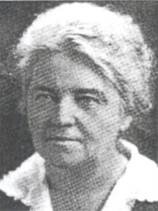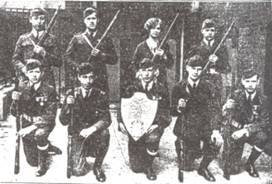Boys Rifle Marksmanship
By ROBERT PRUTER
Rifle marksmanship has never attracted a large number of schools in the state of Illinois. During the sport's heyday, from approximately 1930 to 1960, it attracted around 35 Chicago public schools, a few more in the Chicago Catholic schools, and maybe about two dozen more around the state. Even with those numbers, rifle marksmanship never even came close to being adopted by the Illinois High School Association. The sport was always a bit controversial, as many educators looked with disapproval of high school students engaging in a sport designed for military training. By the early twenty-first century, as critics of the sport ended the sport in more and more schools, only a handful of schools in the state were still supporting the sport.
The sport of rifle marksmanship in the Chicago high schools arose directly out of the American experience in World War I. While rifle marksmanship was engaged by some schools prior to the war, it never attracted more than a handful of schools, and the Chicago High School League never sponsored competition in the sport in those early years.
The United States historically was not what might be called a "militaristic" nation, and as a consequence there was little or no military training before World War I in most of the country's public and private schools. The secondary schools at the time simply were not thought of as institutions designed to prepare young people for the military, and as a consequence few public schools included in their extracurriculum the military sport of rifle marksmanship. A notable exception in the public school arena nationwide would be the Public Schools Athletic League (PSAL) that served New York City's public schools. The PSAL since its inception in 1903 had as one of its aims to prepare its male students in rifle marksmanship, and its program for the secondary schools was the most extensive in the nation. The chief architect for the rifle marksmanship program was the PSAL head, General George W. Wingate, who argued that America needed to be militarily prepared, and the "only way this country will ever become prepared for war is to have the people in mass trained in the use of the rifle."
Thus, prior to World War I, Chicago was far behind New York in support of high school rifle competition. The Chicago public schools administration elicited no interest in developing such a rifle marksmanship program. Instead, the impetus for rifle competition came from individual schools and outside groups, notably the Illinois State Rifle Association, the First Regiment Armory, and the Sportsman's Club of America. The first Regiment Armory provided its facilities for most of the high school meets, and the Sportsman's Club encouraged local high schools to use its facilities for practice. The idea behind the Sportsman's gesture was to spur the development of the sport with the idea (dream actually) of making rifle shooting a "major sport in the Chicago High School League."
A small number of Chicago public and private secondary schools began adopting rifle shooting around 1909 and 1910. Some of the pioneering schools in the area were Crane Tech, Lake View, Hyde Park, Englewood, University High, and Morgan Park Military Academy. In response to this burgeoning interest, in 1910 the Illinois State Rifle Association added an interscholastic state championship section to its sections on regimental rifle shoots and revolver team matches for police departments. Crane Tech emerged as one of the biggest proponents of the sport. Crane teams became so dominant in the competition that sometimes both its first and second teams would take first and second honors in state and city meets. The school was an all-boys institution and one of the largest in the city, serving many working class boys on the city's immigrant west side. The state meet sponsored by the Illinois State Rifle Association did not appear to have lasted beyond 1916. The Chicago High School League remained uninterested.
Advent of Military Training in Chicago Schools
With the outbreak of the war in Europe in 1914, however, the drumbeat gradually increased in the United States for greater military preparedness as the country increasingly became drawn into the conflict. In 1916, Congress passed the National Defense Act, which under Section 40 called for the establishment of Reserve Officer Training Corps in both institutions of higher learning and secondary schools. Even before the passage of the law, many secondary school systems had begun instituting drill and review and thinking in quite martial terms, and some argued for universal military training in the schools.
In Chicago, the school system introduced military training in the high schools in the spring of 1917, but had been developing a plan for an optional course in military training as early as August 1916. The beginnings were modest, in which participation was voluntary and the number admitted to the cadet corps was 3,000. Within a year, the military training was made compulsory. That the idea of turning public high schools into a feeder system for the armed forces might seem to some as perhaps un-American--reminiscent of Kaiser Germany or some other European state were militarism was more politically and socially accepted—but the Chicago school authorities argued that military training was advancing the American way. Said the superintendent's report, "One of the main ideas underlying the introduction of military training in the high schools was to make them a real democracy by putting every boy in the same sort of clothes and requiring of each exactly the same duties."
Military training in the Chicago schools in its first year for the students at large consisted of a course of two-armed semaphore signaling, making dummy Mills Bombs and dummy grenades, war games; and for the cadets a program of wall scaling, drill, and review. For the general student body, competition was held in signaling, but the grenade throwing was cancelled because of inclement weather. Competition was held for the cadets in one giant extravaganza at Grant Park on Chicago's lakefront. Each high school was represented by one company. Competitive drill was won by Englewood High; wall scaling, by McKinley High; and competitive review, by Hyde Park High. In the late spring of 1918—in the first small step to introduce riflery into the Chicago schools-- the first rifles arrived from the Rock Island Arsenal, numbering only 750. Some instruction was given in nomenclature, care, and handling of the rifles, but no target shooting was done.
The Armistice in November 1918 did not end military training. The Chicago public schools put military training on a permanent basis with the formation of Reserve Officer Training Corps (ROTC) in the schools in early 1919. The system had 21 high schools that served male students at the time, and every one of them formed ROTC units. ROTC constituted a two-year elective course, requiring three hours a week training. The War Department each year assigned to the school system a certain number of officers and non-commission officers to conduct the training. In April, 1919, 12,000 ROTC enrollees—6,000 on the North Side and 6,000 on the South Side—were inspected for review by a representative of the War Department. That summer, the first military camp (Camp Roosevelt) was held near Muskegon, Michigan, for some 1,300 students. This camp continued throughout the 1920s. Within a couple of years, most of the schools also were sponsoring bands organized on a military model, with the students wearing brown uniforms and subject to military-style direction. Rifle marksmanship was now included in the training at ranges in the schools and at the armories, although formal competition had yet to be introduced into the schools.
Rifle Marksmanship via ROTC
During the early 1920s, rifle marksmanship via ROTC gradually became a part of the Chicago schools interscholastic program. The rifle competition initially was not league-sponsored but involved outside tournaments, most notably the U.S. Army Sixth Corps competition and the National Outdoor Life Exposition.
In lieu of the absence of a league competition, the National Outdoor Life Exposition, held every year at the Chicago Coliseum served as the city championship meet for Chicago schools. The Exposition sponsored both a boys and a girls competition, around mid-May of each year. The last matches appeared to have been in 1925, after the Chicago High School League had inaugurated its league tournament during late February and early March.
Outside contests were conducted two ways, by actually meeting the school at a shooting gallery and tallying the scores (the National Outdoor Life), and by shooting at a designated range with a designated observer and telegraphing the score to the meet officials (the Sixth Corps competition). Telegraphic meets were also held between schools, competing on their home ranges. In 1923, for example, Evanston High competed against Lawrenceville Prep in a telegraphic meet. Chicago schoolboys and schoolgirls were not big fans of telegraphic meets, as one Lake View school newspaper reporter remarked, "The Sixth Corps Area was fired by the team but not much enthusiasm is evinced by the teams in these 'mail-order' matches, for reason that the shooting is done at their own ranges and therefore all the excitement is lost."
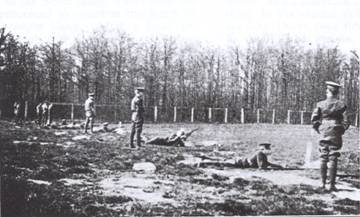
Evanston 1926 rifle team at outdoor competition
The Chicago Public High School League's initial conference championship match followed a series of elimination matches. In the championship match Lake View beat Englewood to take the first league title. By the early 1930s the competition involved a regular season of dual meet matches that winnowed out four teams that competed in the league championship tournament, usually held in the late fall. The high school competitors used 22-caliber rifles and shooting was done at targets 50 feet away from four positions—prone, standing, kneeling, and sitting. This competition involved direct competition at shooting galleries, usually in the basements of the schools. The annual city tournament was held at an outside range, notably the Hamilton Club Rifle Range.
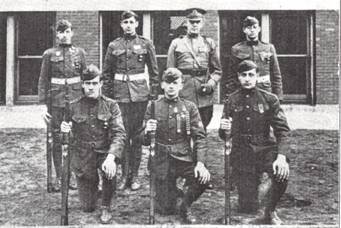
Englewood rifle team 1924
The preeminent Chicago public school in rifle marksmanship was Lake View, which by the standards of other public schools in the city was heavily militarized. It had the city's largest ROTC battalion, with four large companies, and its ROTC chapter won all the city's drill competitions. Of the 6,000 students enrolled in ROTC in approximately twenty Chicago high schools, 425 of them were from Lake View. The school's military band also won more than its share of league titles. Lake View's boys rifle team won the city league championships annually, from 1924 through 1931. While the league did not provide a title competition for girls rifle, the Lake View girls likewise did well in outside competition.
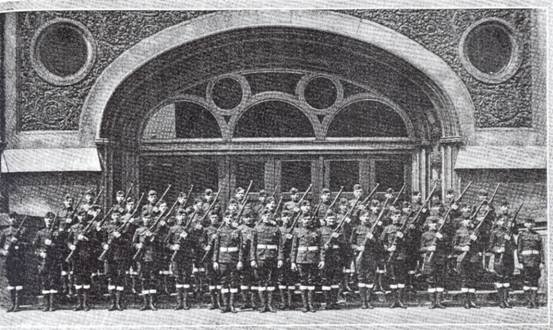
Lake View ROTC crack unit that won the 1925 competitive drill championship
An interesting twist to the Lake View rifle teams was that their shooting coach was a woman, Mary Monahan, described in the school yearbook as "the only woman rifle coach in the country" [meaning for boys]. Not only that, but in 1927 she was assisted in the coaching both the girls and boys teams by a student, Mary Ward, who achieved national fame that year as "Sure Shot" Mary for her perfect scores in both high school and national contests, notably in the Chicago league competition shooting 500 out of 500. For this achievement she was written up in "Ripley's Believe it or Not." "Sure-Shot Mary" in 1929 fired as a member of the Dewar Team (the Davis Cup of riflery).
|
|
In the suburbs, the schools with the most advanced marksmanship programs were mostly located on the North Shore, mainly Evanston, Waukegan, and Deerfield-Shields (in Highland Park). Military academies in Illinois that did well included Northwestern Military Academy in Highland Park and Morgan Park Military Academy in Chicago.
Outside Competition
Rifle marksmanship was something of a year round sport in the Chicago high schools. The schools competed for the league championship early in the schools year, and in the spring term competed in a series of outside competitions, notably the National Rifle Association (NRA) national championship, Hearst Trophy Match, and the Winchester Junior Rifle Corps Interscholastic Championship.
The premier secondary school national rifle competition was sponsored by the National Rifle Association (NRA), headquartered in Washington, D.C. The NRA first sponsored the competition in 1909, and after a lapse in the competition during World War I, the competition was resumed in 1920. The organization conducted separate competitions for high schools and military academies, and sometimes in different classes. In the high school competition, Washington D.C. Central and California schools tended to dominate the competition during the decade; Culver and St. John's of Delafield, Wisconsin, dominated the military academy competition. The best achievements by Illinois schools was in 1914 when Northwestern Military Academy (Highland Park) took the Class B title for military academies, in 1915 when Morgan Park Military Academy took the Class B title for military academies, and in 1927 when Crane High took the NRA national title for high schools.
Another national competition was the William Randolph Hearst's annual trophy competition, usually held in May of each year and well publicized in the Hearst chain of newspapers. The trophy was not given to high school rifle teams per se, but to ROTC rifle teams. By 1927, there were 111 schools participating in the annual contest. Army officers served as official referees at the ranges where the competitions were held. All the participating teams were annually ranked both nationally and in their region or city. For example, Chicago's Fenger High bragged that its team went from 57th place in the country in 1924, to 11th place in the country in 1925, to 4th in the country and 1st in Chicago in 1926. Waukegan High did the best of Illinois schools, winning three consecutive national titles during 1925-27.
The Winchester Junior Rifle Corps competition, sponsored by the Winchester Rifle Corporation, was a popular national rifle tournament of the 1920s, and was usually held in March and April of each year. High school competition included a national boys competition and a national girls competition, the latter usually won by Crosby High of Waterbury, Connecticut. Evanston High claimed two national Winchester titles, in 1923 and 1924. Other divisions of the competition were for Y.M.C.A.s, Boy Scout Troops, and miscellaneous groups, such as church teams and messenger boy teams, grouped in an open division.
During the 1920s and 1930s, the Sixth Army Corps sponsored competition in the states that it encompassed—Illinois, Michigan, and Wisconsin—and such Illinois schools as Lake View and Rockford took titles during the early 1930s.
In 1936, Morgan Park Military Academy began hosting the Midwest Interscholastic Rifle Meet under joint sponsorship of the Illinois Rifle Association and the National Rifle Association. The meet was open to both girls and boys teams. Most of the girls teams represented private clubs and organizations, but some teams represented high schools, notably Quincy High, Loring High, and Hyde Park High.
The first year of the Midwest Interscholastic, only five Chicago area schools sent teams, but by 1938 seventeen schools from around the Midwest were participating. In 1940, University of Chicago took over as host institution and was opened to junior shooters and renamed the Midwest Junior Rifle Meet. The last meet was held in 1941. The University of Chicago did not include a junior section in its 1942 meet, and the 1943 meet was cancelled because war needs limited transportation and ammunition supplies. During the history of the meet, the boys division was won by Lake View in 1936 and Evanston in 1939. Culver Military Academy won three times, and Loras Academy in Iowa won once.
After World War II, rifle competition in the Chicago Public High School league flourished, and more than thirty schools competed annually for the league championship held every December. Girls interscholastic competition briefly revived when in the late 1940s some five Chicago high schools sponsored girls rifle teams. By the 1950s, however, only the boys competition remained.
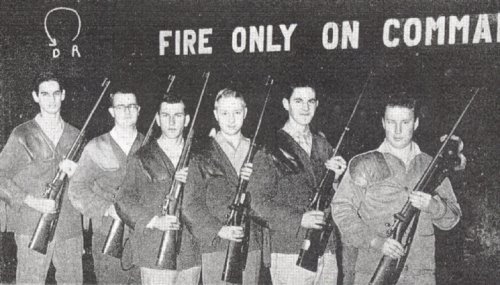
Austin, 1958
The Demise in Chicago
The Chicago Public League ended its championship rifle meet with the 1963-64 season. Lindblom took the last title. However, individual schools through their ROTC programs continued to support rifle marksmanship. In 1968, following a burglary of the Tilden Tech rifle room, the U.S. Army removed all rifles from 36 Chicago high schools. This was at the height of the Vietnam War, and many Chicago educators began to question the presence of the military in Chicago high schools as well as the continued ROTC training in rifle marksmanship. The Chicago Region PTA in 1969 asked the Board of Education to review the program and review the expense involved in rehabilitating the rifle ranges in the high schools.
Despite the opposition to the program, ROTC rifle marksmanship training continued. Eventually, with the admission of girls into ROTC in the early 1970s the program had girls shooting rifles again. By the mid-1990s, Chicago with more than 7,000 students enrolled in 33 Army units, two Navy units, and one Marine unit had the largest ROTC program in the country. The rifles were now air-powered and shot pellets. Rifle marksmanship competition had returned, and in the 1990s more than 30 Chicago schools and a somewhat smaller number in the rest of the state were competing in marksmanship competition.
By the end of the 1990s, however, the issue of guns in our society had become highly controversial in the wake of the shootings at Columbine High in Colorado in April of 1999. Educators began enforcing "zero tolerance" policies on the bringing of weapons or even small items that could be used as weapons into the schools. The existence of guns and firing ranges within the schools in such an atmosphere became more and more problematic. In November 1999, after a Chicago Tribune article appeared on rifle marksmanship training and competition in Illinois high schools, Superintendent Paul Vallas became of aware of the program for the first time. Within a week, he ended the rifle marksmanship program, abolishing all training classes and all rifle teams and competitions. Vallas said the rifle program was "unseemly and incongruous after fatal school shootings in Colorado and elsewhere."
At the time of the shutdown of the program, some 9,000 Chicago students were enrolled in ROTC, but only 1,000 in 33 schools were taking marksmanship training, which was required for only one semester during the school year. In interscholastic competition, the Chicago Tribune listed 33 schools as having rifle teams, among them such long-time competitive riflery powers as Lake View, Lane Tech, Bowen, and Schurz. No newspapers reported on this rifle competition, and the sport was so low profile that most students in the high schools were unaware that their schools even had rifle teams. Lane Tech had won the two previous Public League competitions with little awareness from its student body.
Elsewhere in the state the Chicago Tribune reported that such Chicago suburban schools as Romeoville, Waukegan, Zion-Benton, North Chicago, and Marmion Academy all sponsored rifle teams. Downstate, the Chicago Tribune listed Auburn, East Richland, Hillsboro, Iroquois West, Mattoon, Pekin, Peoria Manual, and Quincy. Some of these school competed using 22-caliber rifles, notably Waukegan, Quincy, and Marmion. But rifle marksmanship in the early 2000s remains a sport of very few schools, remains virtually invisible, and remains virtually unknown.
Photos: Chicago Tribune, 17 March 1927
Published with permission. All rights are reserved by the author.
The opinions expressed in this article are those of the author and not necessarily those of the Illinois High School Association.
